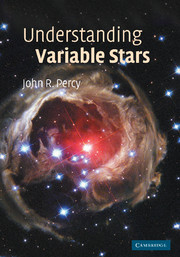Book contents
- Frontmatter
- Contents
- List of Boxes
- List of Figures
- List of Tables
- Preface
- 1 History and development
- 2 Stars
- 3 Variable stars
- 4 Rotating variable stars
- 5 Eclipsing variable stars
- 6 Pulsating variable stars
- 7 Eruptive variable stars
- 8 Pre-main-sequence variable stars
- 9 Miscellaneous variable stars
- 10 Epilogue
- Appendix: Acronyms
- References
- Resources
- Index
3 - Variable stars
Published online by Cambridge University Press: 28 October 2009
- Frontmatter
- Contents
- List of Boxes
- List of Figures
- List of Tables
- Preface
- 1 History and development
- 2 Stars
- 3 Variable stars
- 4 Rotating variable stars
- 5 Eclipsing variable stars
- 6 Pulsating variable stars
- 7 Eruptive variable stars
- 8 Pre-main-sequence variable stars
- 9 Miscellaneous variable stars
- 10 Epilogue
- Appendix: Acronyms
- References
- Resources
- Index
Summary
Variable stars are stars which change in brightness. The change may be as small as a few parts in a million, or it may be a factor of a thousand or more. It may occur in a second or less, or it may take years, decades, or centuries. These are extremes, but astronomers have developed an array of techniques for discovering, measuring, and analyzing the full range of possible variable stars. Why? Because the variations provide important and often-unique information about the nature and evolution of the stars. This information can be used to deduce even more fundamental knowledge about our universe in general.
The variations may be due to the rotation of a spotted star, or to an eclipse of a star by a companion star, or even by an unseen planet. The variations may be due to the vibrations of a star; if they are complex enough (as they are in our sun), they may provide an internal ‘picture’ of the star, like a CT scan. The variations may be due to eruptions on a star (flares), or an accretion disc (dwarf novae) or major explosions on a star (novae), or to the total disruption of a star in a supernova. Supernovae are the most violent events in our universe, yet we owe our existence to them, because they help to recycle the atoms, created in stars, into space, where some of them became part of our sun, our planet, and our biosphere.
- Type
- Chapter
- Information
- Understanding Variable Stars , pp. 48 - 80Publisher: Cambridge University PressPrint publication year: 2007



